SERIES CIRCUITS
A series circuit is the simplest circuit. The conductors, control and protection devices, loads, and power source are connected with only one path to ground for current flow. The resistance of each device can be different. The same amount of current will flow through each. The voltage across each will be different. If the path is broken, no current flows and no part of the circuit works. Christmas tree lights are a good example; when one light goes out the entire string stops working.
A series circuit is the simplest circuit. The conductors, control and protection devices, loads, and power source are connected with only one path to ground for current flow. The resistance of each device can be different. The same amount of current will flow through each. The voltage across each will be different. If the path is broken, no current flows and no part of the circuit works. Christmas tree lights are a good example; when one light goes out the entire string stops working.

Therefore:
1. An open in the circuit will disable the entire circuit.
2. The voltage divides (shared) between the loads.
3. The current flow is the same throughout the circuit.
4. The resistance of each load can be different.
The combined resistance in the above circuit is equal to the sum of individual resistance R1 and R2. In other words: The total resistance is equal to the sum of all resistances (R1 + R2 + R3 + .......)

Therefore, the strength of current (I) flowing in the circuit can be found as follows:

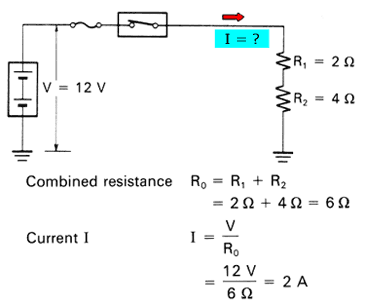
PARALLEL CIRCUIT
A parallel circuit has more than one path for current flow. The same voltage is applied across each branch. If the load resistance in each branch is the same, the current in each branch will be the same. If the load resistance in each branch is different, the current in each branch will be different. If one branch is broken, current will continue flowing to the other branches.
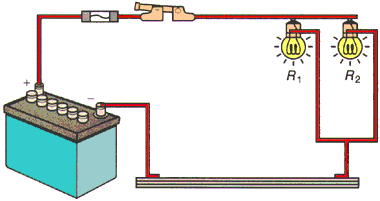
Therefore:
1. In the event of an open in the circuit in one of the branches, current will continue to flow through the remaining.
2. Each branch receives source voltage.
3. Current flow through each branch can be different.
4. The resistance of each branch can be different.
Resistance R0 (a combination of resistances R1 and R2) in a parallel connection can be determined as follows:

From the above, the total current I flowing in this circuit can be determined from Ohm's law as follows:
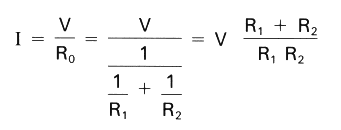
The total current I is also equal to the sum of currents I1 and I2 flowing through individual resistances R1 and R2

Since battery voltage V is applied equally to all resistances, the strength of currents I1 and I2 can be determined from Ohm's law as follows:

Resistance RO (a combination of resistances R1 and R2, which are connected in parallel in the circuit as shown below), the total current I flowing in the circuit, and currents I1 andI2 flowing through resistances R1 and R2, can be determined respectively as follows:
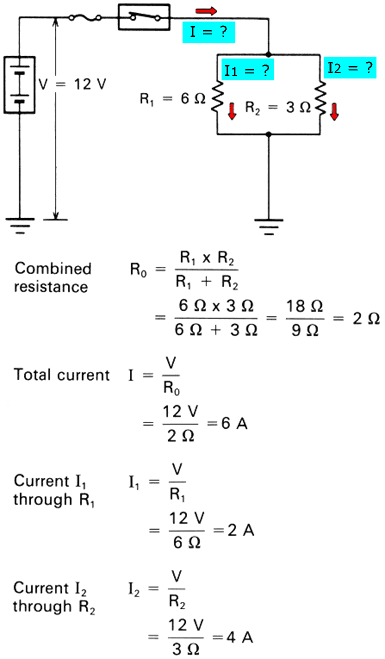
SERIES PARALLEL CIRCUIT
A series-parallel circuit has some components in series and others in parallel. The power source and control or protection devices are usually in series; the loads are usually in parallel. The same current flows in the series portion, different currents in the parallel portion. The same voltage is applied to parallel devices, different voltages to series devices. If the series portion is broken, current stops flowing in the entire circuit. If a parallel branch is broken, current continues flowing in the series portion and the remaining branches.
A resistance and lamps may be connected in a circuit as illustrated below. This type of connecting method is called series-parallel connection, and is a combination of series and parallel connections. The interior dash board lights are a good example. By adjusting the rheostat, you can increase or decrease the brilliance of the lights.
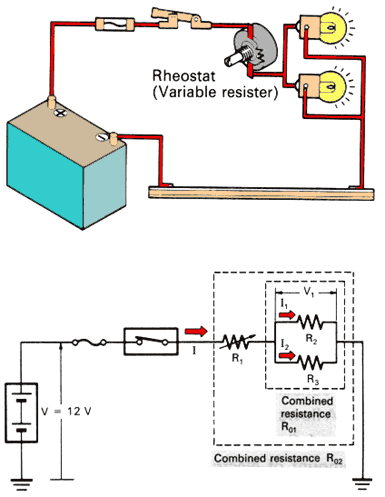
The combined resistance R02 in this series-parallel connection can be determined in the following order:
a. Determine combined resistance R01, which is a combination of resistances R2 and R3 connected in parallel.
b. Then, determine resistance R02, which is a combination of resistance R1 and combined resistance R01 connected in series.
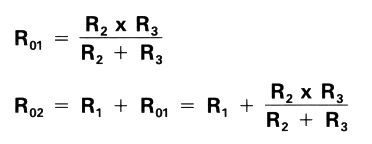
Total current I flowing in the circuit can be determined from Ohm's law as follows:
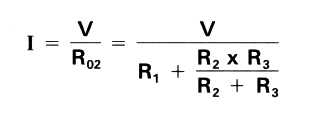
The voltage applied to R2 and R3 can be found by the following formula:

Currents I1, I2 and I flowing through resistances R1, R2 and R3 in the series-parallel connection, as shown below, can be determined as follows:
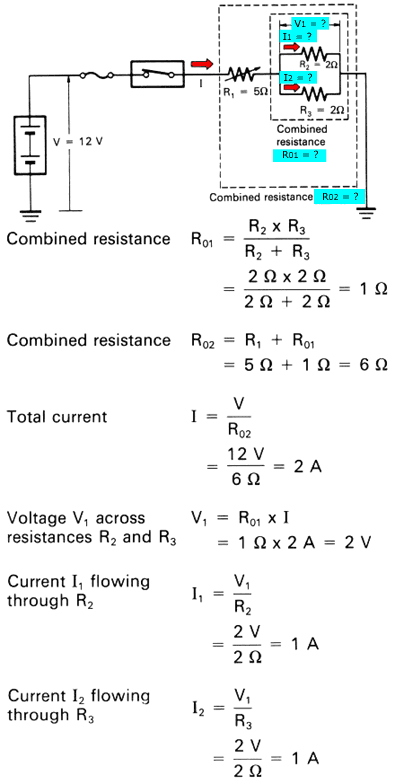
No comments:
Post a Comment